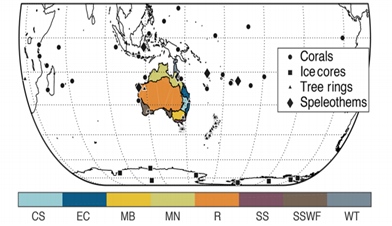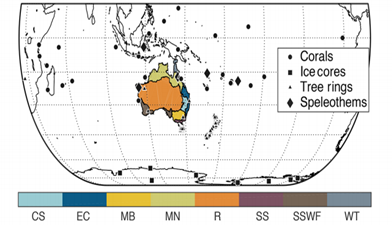Trees, corals, ice and caves: Nature’s records of Australian droughts and flooding rains

Australia is a continent of extremes and has been inhabited by Indigenous peoples for thousands of years. Yet we know little about its past climate. Our new study uses tree rings, corals, ice cores and cave sediments from around the Southern hemisphere to reconstruct seasonal rainfall several centuries into the past. With this new knowledge, we can better equip ourselves for a future of droughts and flooding rains in the context of a rapidly warming world.
Perhaps more than many other continents, Australia has been shaped by floods, droughts, and blistering heat. While records of European meteorological observations date back to 1650, systematic weather observations in Australia only began in the late 19th Century. Even in this relatively short period, many parts of the continent have experienced prolonged wet periods and droughts. The Federation Drought (1895–1903) was the first multi-year period of below average rainfall since instrumental data collection began. There were also pronounced rainfall deficits during the World War II Drought (1939–1945) and the Millennium Drought (1997– 2005). All had devastating effects on regional agriculture and the broader economy. Importantly, each of these droughts had very distinct characteristics in terms of the spatial footprint, duration, and intensity—they also differed in terms of their seasonality.
Although a wealth of information about the frequency of wet and dry extremes can be derived from observational records, these records can’t provide us with the full picture. To help understand the likelihood of the continuation of late 20th century changes as well as the underlying chance of prolonged drought, it is essential that we understand the longer-term climatic context. For this, much longer records are required.
A recent study significantly extended the record of Australian rainfall, with a 400-800 year reconstruction into the past. The investigation carried by our group of researchers from the University of Melbourne (Mandy Freund, Benjamin J. Henley, David J. Karoly, Kathryn J. Allen, Patrick J. Baker), using an extensive network of paleoclimate proxies from the Southern Hemisphere, not only showed that some recent shifts in rainfall variability are either unprecedented or very rare over the reconstructed period, but also provided a historical context for assessing the spatial and temporal extent of recent drought events. Hence, the study highlights the importance of long-term data for better understanding of the regional extent, duration, intensity, and seasonality of Australian climate.
Spatial proxy distribution in the Southern Hemisphere
The paper, published in the Journal Climate of the Past, offers the first ever research that places recent rainfall observations into a long-term context across the whole of Australia, to better understand the past climate variability and be better prepared to explain future conditions.
We used the links between palaeoclimate and large-scale conditions in the ocean basins and atmosphere to reconstruct rainfall. Importantly, we did this for two seasons, the cool (April–September) season and warm (October–March) season, over eight large natural resource management regions spanning the Australian continent. This reconstruction allows us, for the first time, to place recent observations at twice-annual temporal resolution into a pre-instrumental context, across the entire continent of Australia.
Our research into Australia’s climate over recent centuries is important because it provides a unique picture of drought characteristics in terms of their regional extent, duration, intensity, and seasonality. This complements the recent Climate Change in Australia report, by providing a new, long-term perspective that will help to better understand recent and future droughts across the Australian continent.
Article: ”Multi-century cool- and warm-season rainfall reconstructions for Australia’s major climatic regions”. Freund, M., Henley, B. J., Karoly, D. J., Allen, K. J. and Baker, P. J., Clim. Past, 13(12), 1751–1770, 2017, doi.org/10.5194/cp-13-1751-2017

